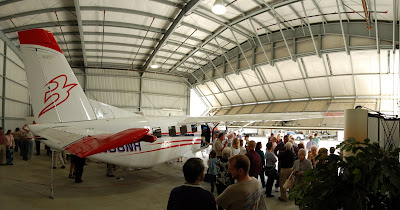Note: you may want to go find some of those red/blue 3D glasses.
The first thing I should explain is how 3D pictures work. Our brain perceives depth because it sees things from two slightly different angles. Our eyes will center on whatever we're looking at. If it's closer our eyes have to aim towards each other slightly more than when we're looking at something far away. Our brain can tell how much our eyes are crossing and then determine how close something is.
Normal pictures only give our brain one viewpoint. Sure, we're looking at it with two eyes but the only distance information that our brain is getting is how far away the screen or print of the picture is. This can be used to create some pretty cool scale illusions if done properly, but that's another blog entry in itself. Back to 3D. You can observe this by looking at your finger and slowly moving it towards your nose. Things in the background will become less and less aligned the closer your finger gets. They will also get blurry but that's because of the lenses in your eyes.
This next paragraph is kinda boring, skip past it if you don't care about tech stuff.
There are a few different ways to get two dimensional screens to send different pictures to each eye. If you go to a movie theater it will be one of two methods. If the glasses are cheap looking and have no way of having electronics in them it's by polarization. If you don't know what polarization is then the next part wont make much sense. Each perspective is from a different projector. One projector will have a vertical polarizer over the lens and the other will have a horizontal filter. The glasses will have one lens vertically polarized and the other horizontally polarized so that each eye only sees the image from one of the projectors. The next method which is coming into use is active shutter glasses. These only need one projector. Every other frame is from the same perspective. The computer controlling all of it sends out a radio signal to the glasses which electrically darkens one of the lenses every other frame. This way each eye is only seeing from one perspective. The older, simpler but lower quality method is to use colored filters. This is the method that I use since I don't have a fancy projector system or an expensive 3D monitor. The right eye sees only the blue/green part of the image and the left sees only the red. The final image only has red and blue edges on things because when the colors are added together they recombine into the original color. Another method is quickly alternating between the two perspectives. As far as I know this only woks for still frame stuff. If I get around to it I'll add one of these to this entry. There is also the method that has been used on baseball cards and then there are holographic images made with lasers but I don't feel like talking about those now so go look them up on
wikipedia if you care.
Now the process of how to actually do it.
heh, do it.First you'll need to take some pictures. Since you need a perspective for each eye you need to take two pictures of your subject. You'll have to do some experimentation to get it right but here are some basics. If your subject is something normal sized like a car, person or trees then only take the pictures 6 inches apart at most. If it's small then less than an inch will do. If it's big you can go anywhere from 10 feet to 150 feet for anything from buildings to mountains. Here's an example of two pictures that we're going to use:


Since these are of something small and close I only moved the distance of one key between the shots. The following steps are in photoshop. If you don't have it you should be able to figure out what's going on and apply it to a different program. For people who don't use image editing software much, you can't do this in MS paint, I'm pretty sure you can't do it in picasa either. There are probably some free programs somewhere out on the internet that can do similar enough things.
-In photoshop open both of the files. They will open in two different windows.
-Move the picture of the right perspective onto the picture of the left perspective.
-You should have two layers, Layer 1 and
Background.
-With layer 1 selected click on the "Create new filter or adjustment layer" on the bottom of the layers section and select "levels."
-Select the Red channel and under output level move the slider on the right all the way to the left and hit OK. If you put the left perspective on top of the right perspective, don't worry. Just remember Right Red Remove.
-Select layer 1 and the levels layer you just created (using shift) and right click and select merge.
-Select
Background and create another levels layer.
-This time move the output levels slider all the way to the left for the blue and the green channels and hit OK.
-Nothing on the screen has changed, don't worry. Select "Levels 1" layer and on the the drop down menu above it that currently says "Normal" select "Linear Dodge (add)"
-Now move the top layer around until things near the front of the picture are aligned. If you used my sample pictures it should look something like this.
-You should be able to put on your 3D glasses and see a 3D picture now.
-Now crop it and make sure you do "Save As" so that you don't replace on of the original files.Unless you don't care about the original, in which case just hit "Save"
Photoshop usually defaults to a .psd file format, you'll want to change that to .jpg or .bmp if you want to look at your pictures or share them with others.
When you're taking the pictures, make sure you only move side to side and don't change the zoom. If you are closer or higher it won't turn out as well. If you're confident you took good pictures and it still isn't working, try changing what point is aligned on the screen. Usually something about 1/3 of the way deep into the picture works fairly well. If your pictures were taken really close together lining them up will be really easy but the picture won't pop out of the screen much. If the pictures were too far apart it may not appear to pop out of the screen at all since your eyes don't realize that they're looking at the same thing from two different angles.
The previous example was of something pretty small and as I mentioned the camera was only moved about an inch. In this picture I moved the camera probably closer to a foot between the pictures.
This next picture is of a construction site and they were taken from closer to 10 feet apart.

The next example is of some distant mountains and the pictures are somewhere in the neighborhood of 150 feet apart.

I was so far apart that the trees in the foreground are completely different trees in each picture. If you close one eye and then the other you can see this. Actually, if you follow my instructions literally your eyes will both be closed.
Since we're artificially creating perspectives for our eyes it means that we can play with things. Normally for this all to work, nothing in the picture would move. However, if you purposefully move something you can create an illusion of it either being closer than it is or further away. If you move the object in the same direction as the camera it will appear to be closer. If you move it in the opposite direction as the camera it will seem further away. To do this right you'll probably need a tripod and/or an assistant since you wont be able to just snap two pictures pretty quickly. You don't want to move the object very much. In the example below I moved it maybe 1/8 of an inch. If you're working with things further away the movement will be more. Aligning these trick shots may take a little more time to find the spot that works best.

As with everything else, the best way to figure something out is to go try it for yourself. If you're not sure what distance is going to work don't be afraid to take a bunch of pictures. I only recently started doing this and so far it's pretty fun, it makes otherwise boring pictures pretty cool and other people may actually feign interest in your life after seeing your handiwork.
If you didn't understand anything or I didn't cover a part let me know and I'll write some more.





















